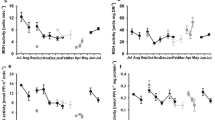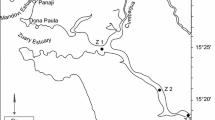Summary
Zooplankton and water samples were collected at weekly intervals between April 25 and May 30, 1986 in Barrow Strait, N.W.T. (Canadian Arctic Archipelago). In tows from 0–30 m, the zooplankton community (>202 μm) was dominated by Pseudocalanus. The population was apparently growing and developing as shown by an increase in the proportion of adults (stage VI) and decreases in the proportion of stages III, IV, and V as the season progressed. Respiration and excretion rates of the Pseudocalanus populations were probably linked, there being an immediate increase in excretion rate, accompanying an increase in feeding rate when chlorophyll concentrations increased, which was followed by a smaller increase in respiration rate after a time lag. Hence, there was a large decrease in the O∶N ratio. Increased metabolism coincided with changes in the population structure, as did protease and bodily protein, but could not be clearly linked to dietary acclimation. Only laminarinase activity could be statistically related to an identifiable fraction of potential nutritional value in the water, particulate soluble carbohydrate, but neither showed overall seasonal change.
Similar content being viewed by others
References
Bamstedt U (1985) Seasonal excretion rates of macrozooplankton from the Swedish west coast. Limnol Oceanogr 30:607–617
Butler EI, Corner EDS, Marshall MS (1970) On the nutrition and metabolism of zooplankton. VII. Seasonal survey of nitrogen and phosphorus excretion by Calanus in the cycle sea-area. J Mar Biol Assoc UK 50:525–560
Conover RJ, Corner EDS (1968) Respiration and nitrogen excretion by some marine zooplankton in relation to their life cycles. J Mar Biol Assoc UK 48:49–75
Conover RJ, Mayzaud P (1975) Influence of potential food supply on the activity of digestive enzymes of neritic zooplankton. Proc 10th Eur Symp Mar Biol 2:415–427
Conover RJ, Hermann AW, Prinsenberg SJ, Harris LR (1986) Distribution of and feeding by the copepod Pseudocalanus under fast ice during the arctic spring. Science 232:1245–1247
Conover RJ, Bedo AW, Herman AW, Head EJH, Harris LR, Horne EPW (1988a) Never trust a copepod — some observations on their behavior in the Canadian arctic. Bull Mar Sci 43:650–662
Conover RJ, Bedo AW, Spry JA (1988b) Arctic zooplankton prefer living ice algae: a caution for zooplankton excretion measurements. J Plankton Res 10:267–282
Corkett CJ, McLaren IA (1978) The biology of Pseudocalanus. Adv Mar Biol 15:1–231
Corner EDS, Cowey CB, Marshall SM (1965) On the nutrition and metabolism of zooplankton. IV. The forms of nitrogen excreted by Calanus. J Mar Biol Assoc UK 45:429–432
Cox JL (1981) Laminarinase induction in marine zooplankton samples. J Plankton Res 3:345–356
Frost BW (1972) Effects of size and concentration of food particles on the feeding behavior of the marine planktonic copepod Calanus pacificus. Limnol Oceanogr 17:805–815
Frost BW (1989) A taxonomy of the marine calanoid copepod genus Pseudocalanus. Can J Zool 67:525–551
Gardner WS, Paffenhöffer GA (1982) Nitrogen regeneration by the subtropical marine copepod Eucalanus pileatus. J Plankton Res 4:725–734
George DG, Hurley MA, Winstanley B (1984) A simple plankton splitter with a note on its reduced subsampling variance. Limnol Oceanogr 29:429–433
Harris RP, Malej A (1986) Diel patterns of ammonium excretion and grazing rhythms in Calanus helgolandicus in surface stratified waters. Mar Ecol Prog Ser 31:75–85
Hassett RP, Landry MR (1983) Effects of food acclimation on digestive enzyme activities and feeding behavior of Calanus pacificus. Mar Biol 75:47–55
Head EJH (1986) Estimation of arctic copepod grazing rate in vivo and comparison with in vitro methods. Mar Biol 92:371–379
Head EJH (1988) Copepod feeding behavior and the measurement of grazing rates in vivo and in vitro. Hydrobiologia 167/168:31–41
Head EJH, Conover RJ (1983) Induction of digestive enzymes in Calanus hyperboreus. Mar Biol Lett 4:219–231
Head EJH, Wang R, Conover RJ (1984) Comparison of diurnal feeding rhythms in Temora longicornis and Centropages hamatus with digestive enzyme activity. J. Plankton Res 6:543–551
Head EJH, Bedo A, Harris LR (1988) Grazing, defecation and excretion rates of copepods from some inter-island channels of the Canadian Arctic archipelago. Mar Biol 99:333–340
Ikeda T (1977) The effects of laboratory conditions on the extrapolation of experimental measurements to the ecology of marine zooplankton. IV. Changes in respiration and excretion rates of boreal zooplankton species maintained under starved and fed conditions. Mar Biol 41:241–252
Ikeda T, HingFay E, Hutchinson SA, Boto GM (1982) Ammonia and inorganic phosphate excretion by zooplankton from inshore waters of Great Barrier Reef, Queensland. I. Relationship between excretion rates and body size. Aust J Mar Freshwater Res 33:55–70
Kotchert G (1978) Carbohydrate determination by the phenolsulfuric acid method. In: Hellebust JA, Craigie JS (eds) Handbook in phycological methods-physiological and biochemical methods. Cambridge University Press, pp 95–97
Lampert W (1986) Response of the respiratory rate of Daphnia magna to changing food conditions. Oceologia 70:495–501
Lowry OM, Rosenbrough NJ, Farr AL, Randall RJ (1951) Protein measurement with the Folin Phenol reagent. J Biol Chem 193:265–275
Mackas D, Bohrer R (1976) Fluorescence analysis of zooplankton gut contents and an investigation of diel feeding patterns. J Exp Mar Biol Ecol 25:77–85
Mayzaud P (1973) Respiration and nitrogen excretion of zooplankton. II. Studies of the metabolic characteristics of starved animals. Mar Biol 21:19–28
Mayzaud P, Martin JLM (1975) Some aspects of the biochemical and mineral composition of marine plankton. J Exp Mar Biol Ecol 17:297–310
Mayzaud P, Poulet S (1978) The importance of the time factor in the response of zooplankton to varying concentrations of naturally occurring particulate matter. Limnol Oceanogr 23:1144–1154
Paffenhöfer GA, Harris RP (1976) Feeding, growth and reproduction of the marine planktonic copepod Pseudocalanus elongatus, Boeck. J Mar Biol Assoc UK 56:327–344
Prinsenberg SJ, Bennett EB (1987) Mixing and transports in Barrow Strait, the central part of the Northwest Passage. Cont Shelf Res 7:913–935
Regnault M (1981) Respiration and ammonium excretion of the shrimp Crangon crangon L,: metabolic response to prolonged starvation. J Comp Physiol 141:549–555
Runge JA (1980) Effects of hunger ans season on the feeding behavior of Calanus pacificus. Limnol Oceanogr 25:134–145
Solórzano L (1969) Determination of ammonia in natural waters by the phenol-hypochlorite method. Limnol Oceanogr 14:789–801
Takahashi M, Ikeda T (1975) Excretion of ammonia and inorganic phosphorus by Euphausia pacifica and Metridia pacifica at different concentrations of phytoplankton. J Fish Res Board Can 32:2189–2195
Vidal J (1980a) Physioecology of zooplankton. I. Effects of phytoplankton concentration, temperature and body size on the growth rate of Calanus pacificus and Pseudocalanus sp. Mar Biol 56:111–134
Vidal J (1980b) Physioecology of zooplankton. II. Effects of phytoplankton concentration, temperature and body size on the development and molting rates of Calanus pacificus and Pseudocalanus sp. Mar Biol 56:135–146
Vidal J (1980c) Physioecology of zooplankton. III. Effects of phytoplankton concentration, temperature and body size on the metabolic rate of Calanus pacificus. Mar Biol 56:195–202
Williams PJL, Jenkinson NW (1982) A transportable microprocessor controlled precise Winkler titration suitable for field station and shipboard use. Limnol Oceanogr 27:576–584
Yentsch CS, Menzel DW (1963) A method for the determination of phytoplankton chlorophyll and pheophytin by fluorescence. Deep-Sea Res 10:221–231
Author information
Authors and Affiliations
Rights and permissions
About this article
Cite this article
Bedo, A.W., Head, E.J.H., Conover, R.J. et al. Physiological adaptations of an under-ice population of Pseudocalanus in Barrow Strait (N.W.T) to increasing food supply in spring. Polar Biol 10, 561–570 (1990). https://doi.org/10.1007/BF00239367
Received:
Accepted:
Issue Date:
DOI: https://doi.org/10.1007/BF00239367




